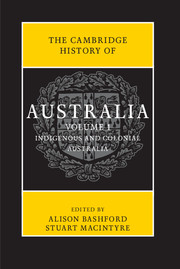Book contents
- Frontmatter
- Contents
- Abbreviations
- List of maps
- List of figures
- List of tables
- Notes on contributors
- Map
- Preface
- Introduction
- PART I
- PART II
- 11 Environmental transformations
- 12 Population and health
- 13 The economy
- 14 Indigenous and settler relations
- 15 Education
- 16 Law and regulation
- 17 Religion
- 18 Colonial science and technology
- 19 Gender and colonial society
- 20 Art and literature: a cosmopolitan culture
- 21 Empire: Australia and ‘Greater Britain’, 1788–1901
- 22 Colonial Australia and the Asia-Pacific region
- 23 The Australian colonies in a maritime world
- Further reading
- Chronology
- Index
- Frontmatter
- Contents
- Abbreviations
- List of maps
- List of figures
- List of tables
- Notes on contributors
- Map
- Preface
- Introduction
- PART I
- PART II
- Further reading
- Chronology
- Index
16 - Law and regulation
from PART II
Published online by Cambridge University Press: 05 November 2013
- Frontmatter
- Contents
- Abbreviations
- List of maps
- List of figures
- List of tables
- Notes on contributors
- Map
- Preface
- Introduction
- PART I
- PART II
- 11 Environmental transformations
- 12 Population and health
- 13 The economy
- 14 Indigenous and settler relations
- 15 Education
- 16 Law and regulation
- 17 Religion
- 18 Colonial science and technology
- 19 Gender and colonial society
- 20 Art and literature: a cosmopolitan culture
- 21 Empire: Australia and ‘Greater Britain’, 1788–1901
- 22 Colonial Australia and the Asia-Pacific region
- 23 The Australian colonies in a maritime world
- Further reading
- Chronology
- Index
- Frontmatter
- Contents
- Abbreviations
- List of maps
- List of figures
- List of tables
- Notes on contributors
- Map
- Preface
- Introduction
- PART I
- PART II
- Further reading
- Chronology
- Index
Summary
Legal institutions were scarcely visible at the founding of New South Wales. It was nearly half a century before the scope of the legal authority claimed by the British settlers over the country's Indigenous inhabitants was determined. Law meant different things to the settlers and the Indigenous people. For the latter, as settlers were only slowly to discover, life and law intersected, overlapped and were inseparable. Law was comprehensive and normative in ways that settlers could not imagine and failed to appreciate. For settlers, law was mutable, its claims over lives and ways of living expanding and contracting as modernity was in process. It was also a weapon that individuals could wield against each other, a shield that might repel the harms directed by others, even by those in authority, against those who had few of the world's resources. Law also meant different things to those in power and those without. In the first century of Australian settlement law was the twin of government; sometimes its critic, at others its instrument. The nineteenth century proved a creative era for law in the scope of regulation, in the reform and refinement of its penalties and in the design of its institutions. But that was only possible after the taking of the country from its first peoples.
Martial law
Dispossession proceeded with the aid of military force, and occasionally under the warrant of that emergency act of executive government, martial law. While even in a penal colony the military remained accountable to law for its actions, martial law rendered immune from prosecution the actions of agents of government. Its deployment against both Indigenous resistance and rebellious settlers signalled the fragility of authority at critical stages of the colonial period. In March 1804 a rebellion at Castle Hill, west of Sydney, by mainly Irish convicts was put down by soldiers despatched by Governor King under a declaration of martial law.
- Type
- Chapter
- Information
- The Cambridge History of Australia , pp. 391 - 413Publisher: Cambridge University PressPrint publication year: 2013



